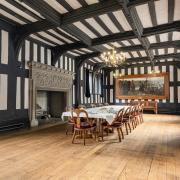Synonymous with luxury, craftsmanship and the kind of beauty that makes even non-car lovers look twice, Bentley has long been the ultimate status symbol.
Everyone from royalty and heads of state to rappers, world-class footballers and film stars has sat behind its hand-stitched leather steering wheels, sharing the experience that comes with owning an icon of the motoring world.
Bentley has the desirability factor most brands can only dream of, which makes it all the more fitting that its Cheshire site is destined to become what’s been called the ‘Dream Factory’.

The Pyms Lane site in Crewe, which employs a workforce of around 4,000 and has been home to Bentley since 1946, is undergoing a transformation that will lead the company into a new era of environmentally-conscious car making.
In 2020, Bentley announced its Beyond100 plan, committing to investing £2.5billion in sustainability over 10 years. The goal is that by 2030, production will be exclusively electric and the process entirely carbon neutral.
The first BEV – Battery-Powered Electric Vehicle – is due to roll off the production line in two years’ time, with a new electric model each year until 2030.


It’s a big, bold strategy that’s designed to position Pyms Lane as a next-generation digital world leader and, in doing so, future proof Bentley’s place at the top of the luxury motor super league.
Which is exactly what the man who gave his name to the company, Walter Owen Bentley – W.O. as he liked to be known – hoped it would be when he founded Bentley Motors back in 1919.
Then, he explained, the policy was simple: 'To build a good car, a fast car, the best in its class.'

Little did he know that almost a century later, probably the world’s most famous Bentley would be gifted to the world’s most famous woman.
Not Kim Kardashian’s Continental GTC – although that did get plenty of airtime – but the one-off limousine built for HM The Queen to celebrate her Golden Jubilee in 2002.
The late Queen, and Duke of Edinburgh, were fans of Bentley and had an input in bespoke features, which included not just high levels of protection but personal touches such as accessory storage designed around the dimensions of Her Majesty's favourite handbags.
In the rarefied realms of high-end car manufacture, it’s that personalisation that makes all the difference.


It’s also the meticulous attention to detail and quality that returned its best-ever financial results in 2022.
At a time when so many companies are struggling with rising costs beyond their control, Bentley’s operating profit shot up to 708milion euros, an increase of more than 300milion euros on the previous year. Car sales also hit a record high in 2022, in excess of 15,000.
That success says Adrian Hallmark, chairman and CEO of Bentley Motors, owes much to the huge – and hugely skilled – workforce in Cheshire.
'Since the low point of 2018, the whole team at Crewe has been working intensively to restructure the business model, in parallel with launching successive new models and features,' he explains. 'An almost €1billion profit turnaround has been achieved since 2018 despite an unprecedented period of disruptions and crises including Brexit, Covid, Ukraine and UK economic instability.

We have built a sustainable financial basis for the long term, a competitive cost structure and unique market positioning that is providing the funding for the most ambitious race to full BEV and carbon neutrality in the luxury sector.
'I’ve been in this industry and in this sector for nearly 28 years and I’ve never seen spending patterns like it, and not just at Bentley. The diversity of what people are ordering, exterior and interior, has fundamentally changed. So, there are more customers out there and they are way more interested now in self-expression and in personalisation.'
A major factor in Bentley’s ability to ride out the economic storm lies in its strong export business. It operates in 67 different markets, with well over 200 retail partners.

The enduring prestige and glamour of ownership mean it’s no surprise that the US is the super-sized, super-rich number one on that list. Last October even saw the launch of a limited edition Beverly Hills collection: three pastel-coloured Continental GTCs inspired by the 1920s and ‘30s golden age of Hollywood.
'The Americas leads as Bentley’s biggest selling global market, marginally in front of China,' confirms Adrian. 'We have a very well-balanced sales distribution model so are not reliant on one market or model. This underlines our brand strength, operational excellence and strong global demand by market and model.
'The reaction to the market introduction of our hybrid models, Flying Spur joining Bentayga last year, demonstrates the path the luxury sector is heading, and we are positioned firmly at the forefront. This sales performance is validation that we not only lead the sector in sales and market share but also investment in electric technologies and commitment to being net carbon neutral in 2030.'

A decade before W.O. Bentley saw the first model bearing his initial B on the badge, his car manufacturing predecessor Henry Ford was famously quoted as saying a customer could have any colour so long as it was black. For Bentley, the future looks bright and green.
Alongside progressive plans for the electric exclusivity of its vehicles, the Pyms Lane factory is setting environmental standards of its own: 20,815 solar panels on the factory roof and 10,000 in the UK’s largest solar-powered car port can supply up to 65 per cent of the site’s electrical needs, generating enough energy to power 1,200 houses a year.
And the combination of a healthy order book and responsible outlook isn’t just good for business and the environment but for the local economy too. More than 700 businesses supply 18,000 parts to the Crewe campus, including 82 based within a 50-mile radius.

A Cheshire location, says Adrian, has been important to Bentley ever since favourable transport links and a skilled labour supply brought the brand’s then owners Rolls-Royce here in 1946. Securing production of the company’s first BEV in Crewe was a milestone moment for Bentley, and the UK, as it plans for a long-term sustainable future in the region.
'For more than 75 years, Cheshire has been synonymous with luxury car manufacturing and during this time, our extraordinary colleagues have produced some of the world’s most iconic and desirable cars.
'Today, we have around 4,000 colleagues in Crewe and are the most sought-after luxury car brand in the world. The combination of fine craftsmanship, using skills that have been handed down through generations, alongside engineering expertise and cutting-edge technology is unique to UK luxury car brands such as Bentley. It is also an example of high-value British manufacturing at its very best.

'With our new ‘Dream Factory’ concept, we now go to zero with water, waste and other environmental impacts until 2030. We are investing over £2.5billion in our future products and Crewe to transform our historic factory by embedding an industry-leading greenfield facility into a world-leading, next-generation digital, low- environmental-impact, high-value advanced manufacturing facility.
'Unique craftsmanship, customer interaction and employee experience will be enhanced by digital tech, higher flexibility and new ways of personalisation.
'We are very proud of our Cheshire roots and we will develop the best of Crewe into the future benchmark of luxury car manufacturing.'

The making of a Bentley Continental GT
• It takes around 110 hours to build a Continental GT
• It takes 45 people six-and-half hours to build one W12 engine
• The engine undergoes a highly-sophisticated test regime taking over an hour, via three specialist diagnostic machines, during assembly
• Around 11 bull hides go into a Continental, (10 for the Convertible version)
• It takes more than 20 hours to cut, stitch and trim the seats and every leather panel is initialled on the reverse by the upholsterer
• Every sheet of wood within a complete car comes from a single tree to ensure consistent pattern and colour. Craftspeople use a technique called mirror-matching when they join sheets, resulting in a continuous grain pattern surrounding the interior
• A Bentley wood specialist views around 25,000sqm of veneer in raw form during selection over two days, checking every centimetre is the finest quality
• Each bundle of veneer consists of 24 leaves
• Every panel is cured for 72 hours, then sanded and lacquered five times to bring its natural beauty to life
• Embroidery is carried out by the 120-strong needlecraft team - some designs feature up to 500,000 individual stitches in bespoke colours
Talent
While Bentley’s universal appeal gives it a far-reaching worldwide customer base, the talent of the future working and innovating to secure its place in that market is largely born in Cheshire.
More than 80 per cent of the company’s apprentices live in the local area around the Pyms Lane site and a fresh influx of apprentices, undergraduates and graduates each year is seen as key to driving its ambitious Beyond 100 plans.
Bentley traditionally creates opportunities for trainees in areas such as manufacturing, engineering and aftersales. Now, with the emphasis shifting to benchmark-setting luxury electric models, training is increasingly focused on electrical systems and digital software technology skills which will support that.
In February this year, to coincide with National Apprenticeship Week, the company announced 37 apprenticeship vacancies based in Crewe, giving school or college leavers the chance to gain world-class on-the-job training, experience and an industry qualification.
Bentley also offers a two-year graduate programme, 12-month industrial placements, in-person and , in partnership with the Speakers for Schools social mobility charity, virtual work experience placements to give 14-18-year-olds an insight into a whole range of STEM career options.
In 2021, as the company marked 75 years since the Bentley Mk VI became the first model off the Crewe production line, it took on 112 apprentices, undergraduates and graduates, its biggest-ever trainee intake.
Timeline
1919: Bentley is founded by Walter Owen Bentley, known as WO, with Cricklewood as its first home
1931: Rolls-Royce buys the company for £125,275, moving production to Derby
1938: The Pyms Lane factory is built in Crewe, originally to make Merlin aeroplane engines
1946: As Rolls-Royce’s Derby plant focuses on jet engines post-war, car manufacture begins at Crewe and the first Bentley, a Mark V1, rolls off the production line
1980: Vickers buys Bentley and drives a revival in sales
1998: Car giants Volkswagen Group buys the company and invests more than £1billion to upgrade the factory
2015: Bentley launches its first-ever SUV, the luxurious Bentayga
2019: Global celebrations take place to mark Bentley’s centenary year
2020: The ‘Beyond100’ strategy outlines Bentley’s aim to be carbon neutral by 2030, exclusively producing battery electric vehicles (BEVs)
2022 Bentley Motors delivers 15,174 – the first time it retails above 15,000 cars in a year



























